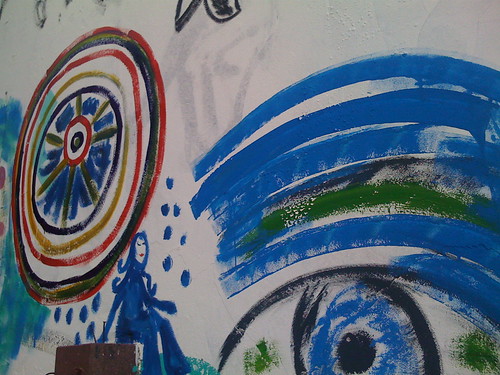Space is the Place

Foto ontem em uma apropriação criativa do espaço: pintura de um muro em Piatã, Salvador.
Acabo de escrever um artigo sobre “Mídias Locativas no Brasil (em tradução para ser publicado em journal canadense) que reforça o tema central do número 21 da Vodafone | receiver, “Space is the place!”. Realmente os desenvolvimentos das mídias da localização e da mobilidade colocam ênfase nos lugares “do mundo aqui em baixo” e não no mundo virtual do ciberespaço “lá em cima”. Escrevi na introdução do meu artigo:
“O atual estágio do desenvolvimento das tecnologias digitais móveis configura-se como uma nova fase da cibercultura, a da ‘internet das coisas’ (van Kranenburg, 2008). Utilizarei aqui a metáfora do download, ou como diz Russel (1999), da internet ‘pingando’ nas coisas. A antiga discussão sobre a irrealidade ou a constituição de uma mundo a parte com o ciberespaço e a cibercultura parecem estar em questão com a virada espacial que o estudos das mídias locativas trazem para o debate sobre os sentidos da tecnologia na cultura contemporânea.
Interessante notar que as mídias locativas, que colocam ênfase nos lugares, são tecnologias da mobilidade, que utilizam dispositivos (laptops, smartphones, PDA, GPS) e sensores RFID, assegurando a conectividade a partir de redes digitais sem fio (Wi-Fi, Wi-Max, 3G, Bluetooth). Movimentar é ‘des-locar’, mas aqui o deslocamento não significa um apagamento do lugar mas uma possibilidade de criação de novos sentido através de práticas sociais como anotações urbana, games baseados em localização, mobilizações políticas, mapeamento, geotags… Se a mobilidade era um problema na fase do upload (sair do local de trabalho ou da casa, incompatibilidade de equipamentos e redes, falta de serviços de localização), hoje, no download das mídias locativas, mobilidade transforma-se em oportunidade para usos e apropriações do espaço público (Dourish et al, 2007). Paradoxalmente, as mídias da mobilidade são as mídias de localização. O que importa é a dimensão do lugar que, além de suas características física e concretas, ganha uma outra, informacional, como banco de dados disparados para dispositivos apropriados a partir da localização e da movimentação do usuário. O lugar deve ser pensado em sua dimensão física, social, cultural, simbólica, imaginária, mas também informacional.
A discussão sobre espacialidade e mídia não é nova, e é bem conhecida as formas de produção social do espaço pelas mídias de massa (telégrafo, jornais, radio, TV) e interpessoais (correio, telefone). As mídias conformam a percepção do espaço e a própria subjetividade em um jogo de espelhos, mostrando nosso lugar no mundo (em relação a outros lugares no mundo), a nossa identidade (em relação a outras identidades), além de organizar o arranjo espacial da sociedade, das cidades, das instituições. Lugar deve ser entendido como fluxo, evento (Thrift, 1999, Massey, 1997, Shields, 1991), cruzamentos de territorialidades, sempre aberto e sujeito a agenciamentos sociais e midiáticos. Novas mídias produzem novas espacialidades.
A cibercultura traz em seu bojo questões ligadas ao espaço. Muitos afirmam ser ela uma cultura do ciber-espaço. Desde o surgimento da internet, a discussão se pautou no espaço virtual, nas relações nas comunidades virtuais, na virtualização de instituições, na webarte, na educação a distância, no e-commerce, no e-governement e na democracia eletrônica. Numa primeira fase a ênfase é o ‘upload’, entendido como transposição eletrônica de corpos, instituições e informações para um ‘lugar’ fora do ‘mundo real’, o ‘mundo virtual’. Agora, com a internet ‘pingando nas coisas’, o download mostra a ênfase na localização, nas informações ligadas ao ‘mundo real’, ressaltando relações espaciais concretas, nas coisas e objetos, nos lugares públicos e privados. O download do ciberespaço cria sinergias e constitui novas territorialidades ‘no mundo real’. Novas possibilidade emergem para reapropriações e ressignificações dos lugares. A expansão global de serviços e tecnologias baseados em localização cria possibilidades para reconfigurações das experiências no espaço público, tanto comerciais como artísticas e políticas. O lugar não é mais um problema para acesso e trocas de informação no ciberespaço ‘lá em cima’, mas uma oportunidade para rever as coisas ‘aqui em baixo’. (…) “
No número da Receiver, os seguintes textos:
Locative media and the city: from BLVD-urbanism towards MySpace urbanism
Sunday, December 7th, 2008 by Martijn de Waal
The geospatial web – blending physical and virtual spaces
Sunday, November 30th, 2008 by Arno_Scharl
The rise of the sensor citizen – community mapping projects and locative media
Monday, November 24th, 2008 by Anne_Galloway
The world as the interface – location data and the mobile web
Monday, November 17th, 2008 by Jon_Follet
Location has been a long time coming – is it now ready for prime time?
Sunday, November 2nd, 2008 by Andrew Grill
Simultaneous environments – social connection and new media
Monday, October 27th, 2008 by Kazys_Varnelis
Creating maps for everyone and network effects for the data driving them
Monday, October 13th, 2008 by Sean_Gorman
Art feature – Tag galaxy
Monday, October 13th, 2008 by Steven_Wood ![]()
With the creation of Tag Galaxy, Steven Wood wanted to explore the way that people use tags and the connections that become visible when this usage is viewed on a large scale. Tag Galaxy lets you browse photos intuitively via virtual planetary systems representing related tags. The application itself does not know of any logical connection between the concepts described by the tags, but as it observes the literally billions of photos which have been tagged by the users of the photo sharing site Flickr, their choices become apparent and a certain level of collective intelligence is achieved.









